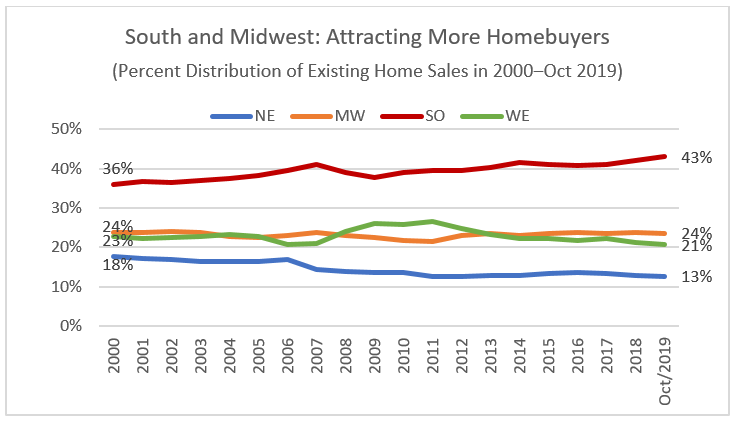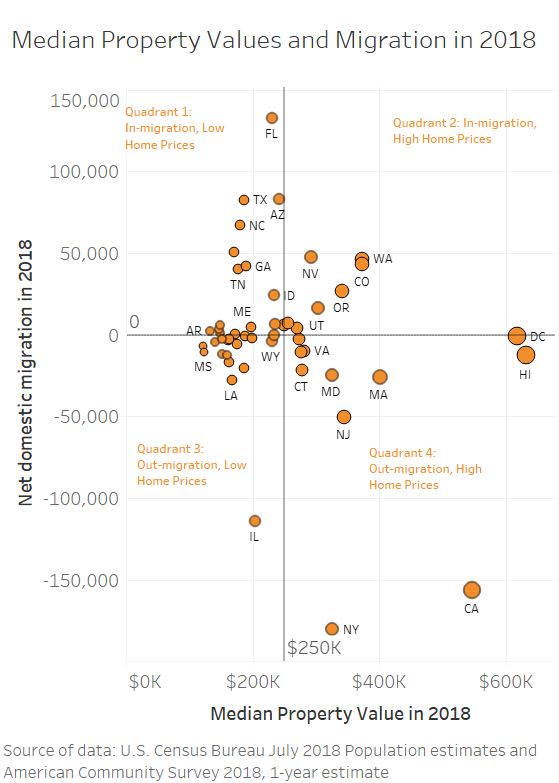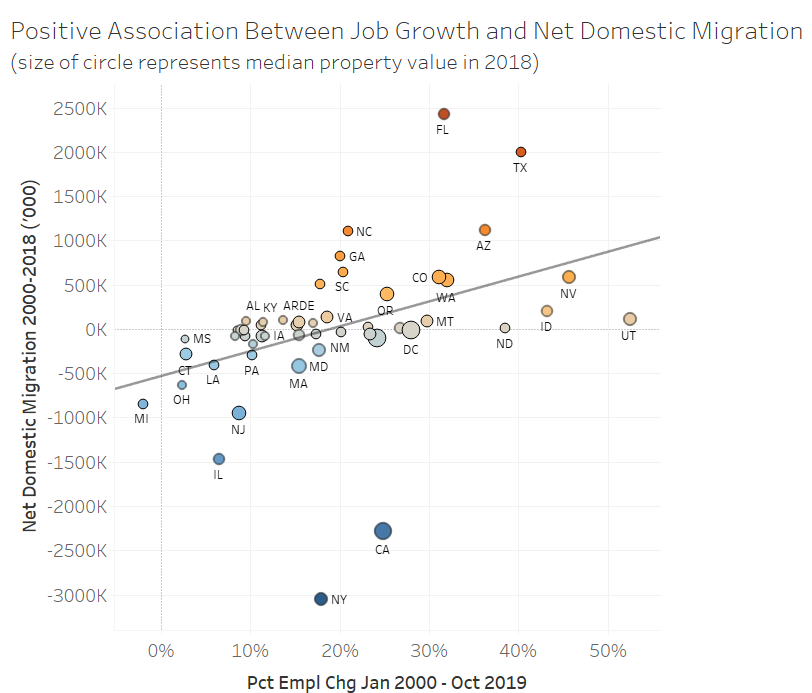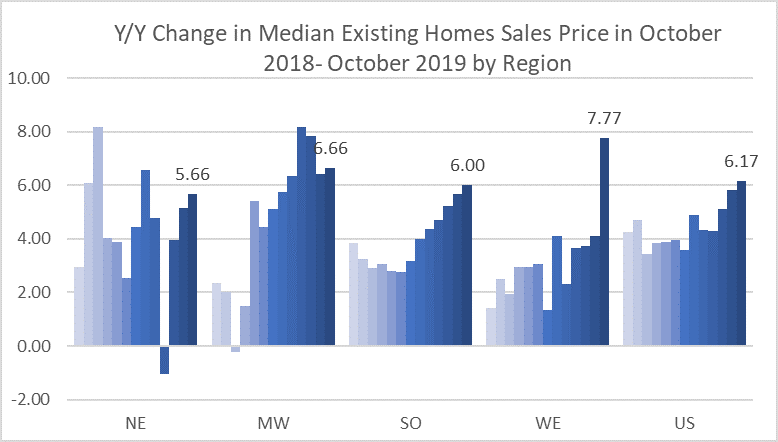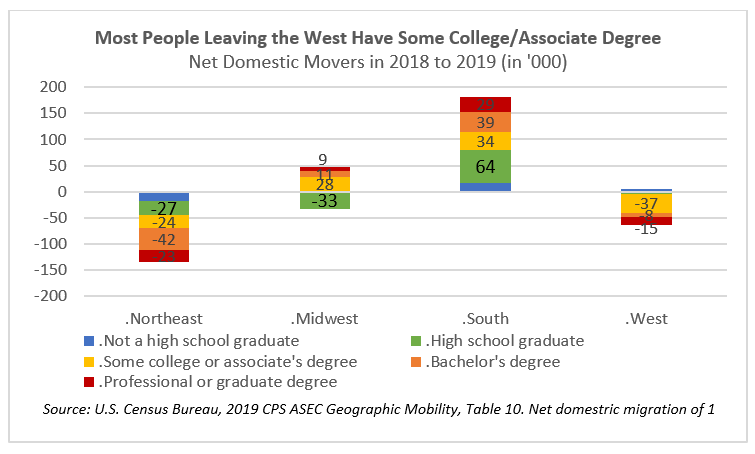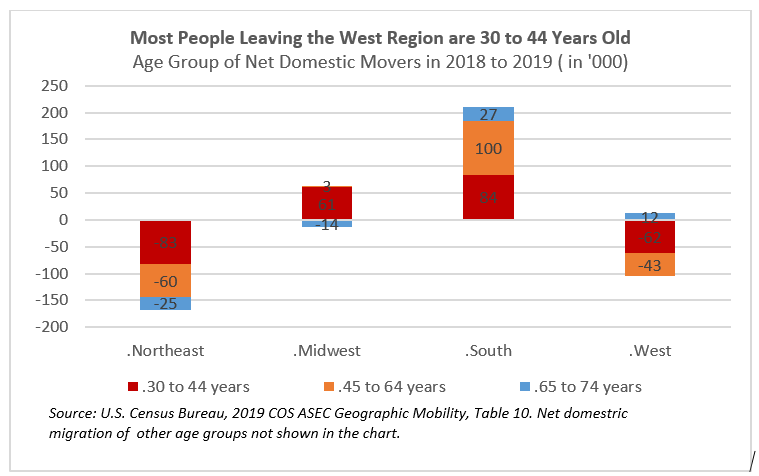The South and Midwest regions have accounted for an increasing fraction of existing home sales since 2012 while the shares of the North and West regions have declined, according to the October 2019 existing home sales estimates of the National Association of REALTORS®. The South region’s share of existing home sales increased from 36% in 2000 to 43% (as of October 2019), while the Northeast region’s share from 18% to 13% during the same period. The West region’s home sales share has slightly fallen from 23% to 21% while the Midwest region’s share has remained the same at 24%. However, since 2011, the Midwest region has been gaining market share, from 21% to 24%. The share of the West region rose to as high as 27% in 2011 but started declining in 2012, to just 21% in 2019.
States with Affordable Prices are Attracting Movers
The increasing share of homes sales in the South region is reflective of the large net domestic migration to the South region. From 2000-2018, net domestic migration1 in the South region totaled 7.3 million, and in the West region, 1.2 million people. Meanwhile, the Northeast lost nearly 5 million people and the Midwest lost 3.4 million from domestic migration.
Properties in the South and Midwest are relatively affordable and are attracting people from other states. Chart 1 below divides states into those with positive/negative migration and if median home values are above or below $250,000 based in 2018 data.
Quadrant 1 states had median property values below $250,000 and experienced net domestic migration, many of them in the South region: Florida, Texas, Arizona, North Carolina, South Carolina, Georgia, Tennessee, Alabama, Arkansas, Idaho, and Minnesota. These states will likely continue to experience in-migration given their relatively affordable home prices.
Quadrant 4 shows states with median property values above $250,000 and which experienced outmigration: California, New York, Massachusetts, Connecticut, Rhode Island, Maryland, Virginia, and Hawaii.
Quadrant 2 shows states that continue to experience in-migration because home values are still affordable compared to those states in Quadrant 4: Washington, Colorado, Oregon, Nevada, Utah, as well as Delaware and Hampshire.
Quadrant 3 states include those have low home values and experiencing net out-migration and includes many Midwest as well as some South states such as Illinois, Mississippi, Louisiana, West Virginia, Ohio, Kansas, Oklahoma, Iowa, Missouri, Pennsylvania, and North Dakota.
Use the data visualization below to view who moved in your state in 2018:
South Region Gains Jobs and Movers during 2000-2018
Job growth is an important factor for domestic migration as shown in the positive association between job growth and net domestic migration as shown in Chart 1 below. During 2000-2018, Florida had the largest net domestic migration, at 2.4 million people, as it created 2.1 million net payroll jobs (32% gain). Florida tends to attract retirees and movers from Northeast states. In 2018, the domestic movers2 from Florida came from New York, Georgia, Virginia, Pennsylvania, Illinois, as well as California.
Texas had the next largest increase in net domestic migration during 2000-2018, at 2 million people, but it created the most jobs, at 3.7 million (40% gain). In 2018, the people who moved from other states into Texas came from California, Florida, Louisiana, Oklahoma, Colorado, and Missouri.
North Carolina attracted 1.1 million and created 798,500 (20%). Arizona, a West region state, saw 1.1 million people movers and created 791,700 jobs (36%).
Other states that had saw net domestic migration and strong job growth were Colorado, Georgia, South Carolina, Tennessee, Oregon, and Washington, and Nevada.
Midwest and South Regions Attracting Movers in 2019
While the Midwest region suffered a loss in population during 2000 to 2018, it is now beginning to experience an increase in net domestic migration. In 2018 to 2019, net domestic migration3 to the Midwest totaled a net of 17,000 people after several years of outmigration. The South continued to have the biggest increase net domestic migration of 263,000 people. Most people moving in the Midwest are in their working years (30-44). The South region continued to attract people from other states, with a net domestic migration of 263,000. The movement of to the South and Midwest has driven housing demand and home price growth.
On the other hand, 238,000 people moved out of the Northeast while 41,000 people moved out of the West region on a net basis. Most movers from the West region have some college or associate degrees who don’t earn as much as those with college or professional degrees.
1 Net domestic migration data from 2000-2018 is from the Components of Population Change NST-EST 2018 (1-year-old and above) downloaded from Haver Analytics. This data measures net domestic migration.
2 Data for 2018 is from the State-to-State Migration Table 1 of the US Census Bureau which it estimates from the American Community Survey 2018, 1-year estimates. These figures represent gross domestic migration.
3 Geographic Mobility Tables, Table A-2, 1981-2019 https://www.census.gov/data/tables/time-series/demo/geographic-mobility/historic.html









